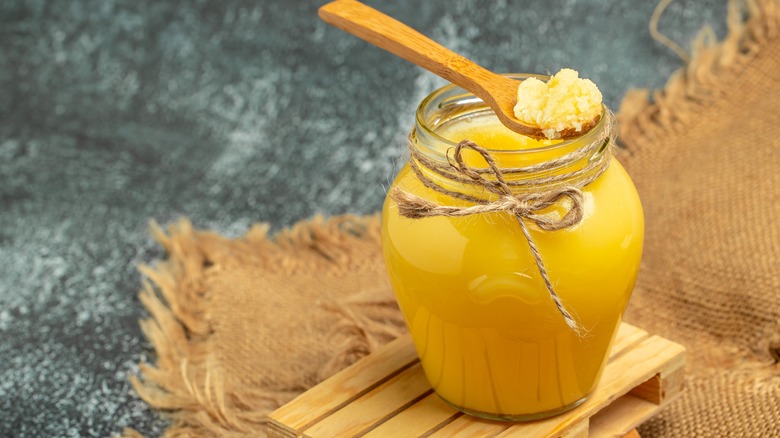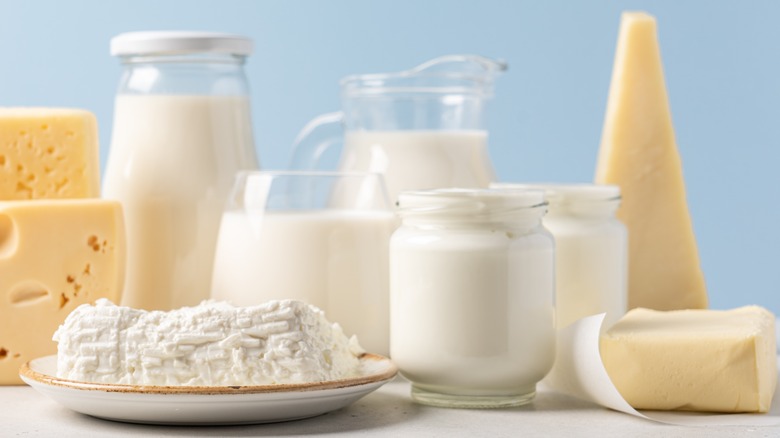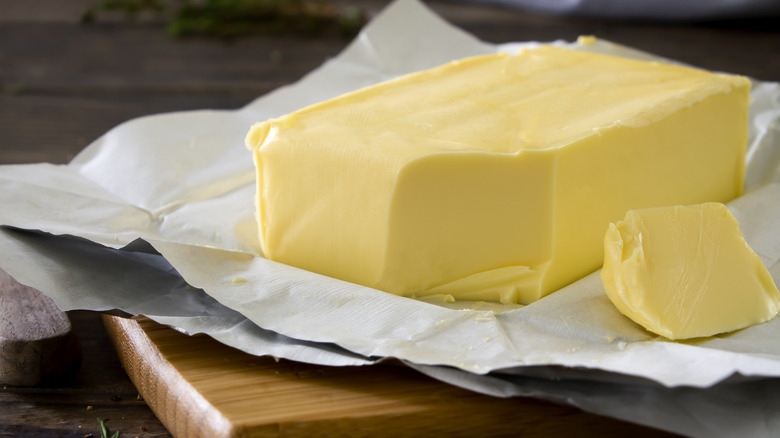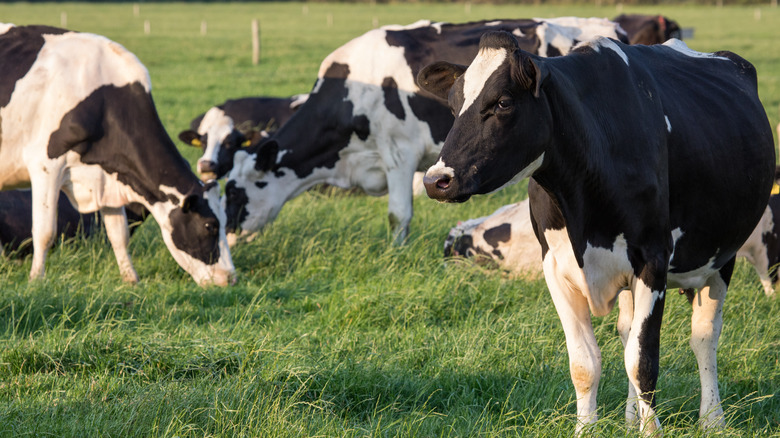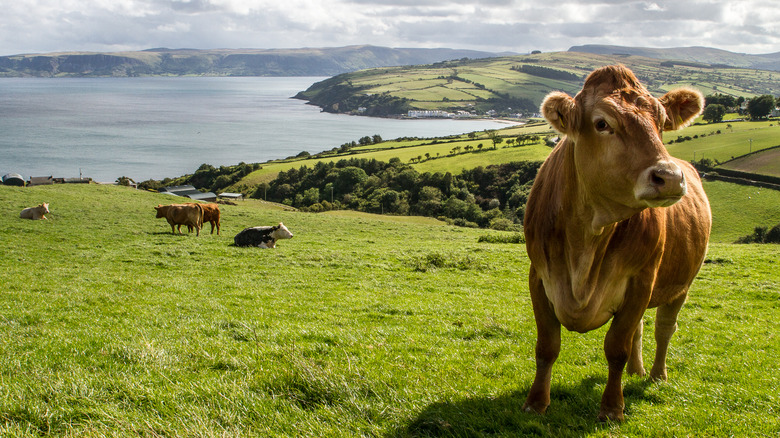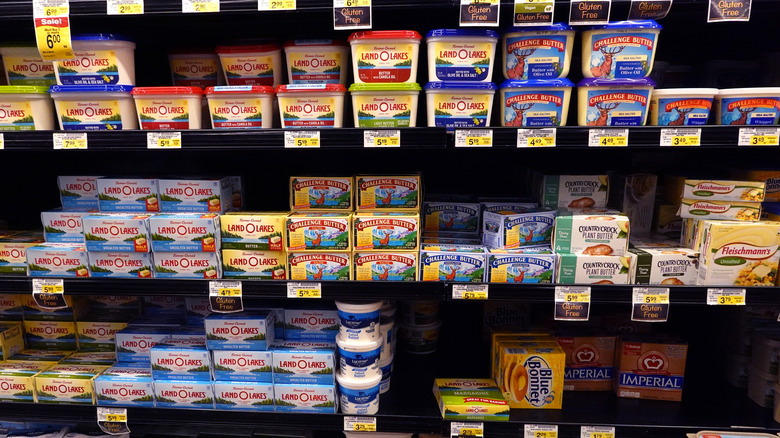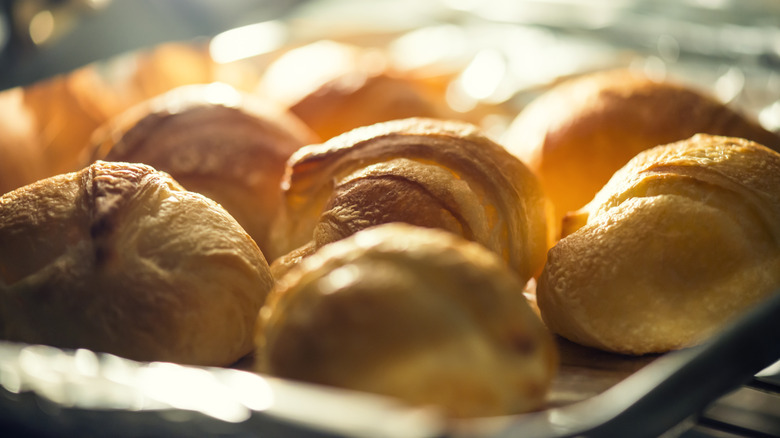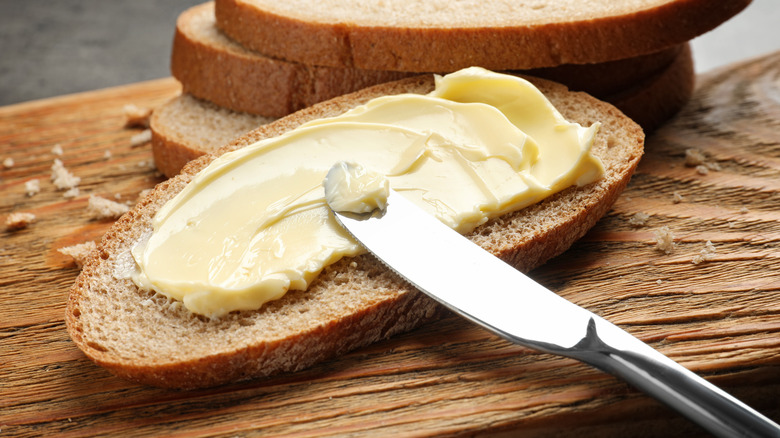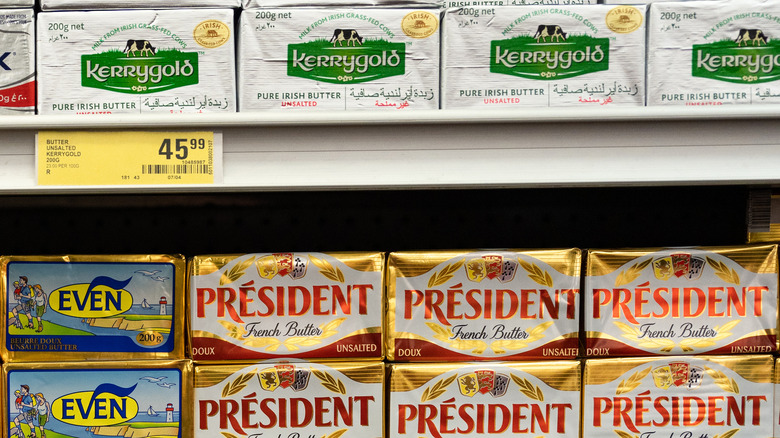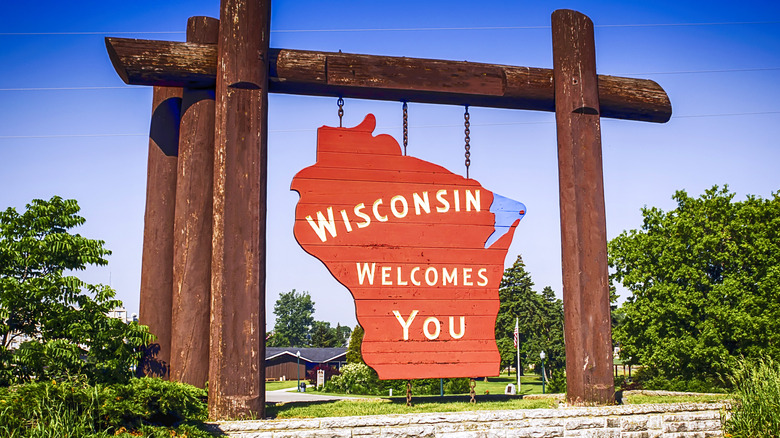11 Facts You Should Know About Irish Butter
Butter's tremendous allure is undeniable. While many condiments can be divisive (looking at you, mayo), butter tends to unify people across countries, cultures, and backgrounds. The earliest use of butter has been traced back to 8000 B.C. in Africa. And 10,000 years later, the decadent dairy product is popular all over the world. But while butter's appeal is near universal, not all butter is the same. It can vary greatly in fat content, color, flavor, texture, and taste. And many of these factors depend on where in the world the butter originated. While no butter is bad butter (unless you let it sit out on the counter too long), some butter is simply better.
Irish butter is widely considered to be among the world's best kinds of butter. Kerrygold, Ireland's most ubiquitous butter brand, is one of the top-selling brands of butter in the U.S. and around the world. It was even ranked the best grocery store butter on the market by Tasting Table. So what is it about Irish butter that has made it the gold standard in spreadable dairy products? It's more than just the luck o' the Irish. Although luck may play a part, there are loads of factors — from climate to fat content to the way the cows are raised — that make Irish butter the literal cream of the crop.
1. Irish butter has a higher butterfat content than American butter
One of the main differences between American and European butter is the butterfat content. The average American butter contains 80% butterfat, whereas European butter typically has a butterfat content of at least 82% or higher. Irish butter follows the European standard of 82% or higher, with some Irish butter brands containing as much as 90% butterfat. It's hardly a news flash that more fat means better taste, so this is one reason Irish butter might make your tastebuds do a little jig.
And higher butterfat affects more than just the taste of your butter — it can also make it last longer. Butter with more fat and less water tends to have a longer shelf life than its lower butterfat equivalents because water breeds bacteria and fat doesn't. Traditionally, Irish butter also contains more salt, which also acts as a preservative. If you like to store your butter on the counter, Irish butter is less likely to go bad within a few days and may last up to a week or longer unrefrigerated if stored correctly. Just don't let it sit out too long, even Irish butter has an expiration date.
2. Unlike most other European butters, Irish butter is typically salted and uncultured
Ireland is a member of the European Union, so all Irish butter is technically European butter, but Irish and European butter are not the same. For one, Irish butter tends to be salted and uncultured, compared to most European butter, which is often unsalted and cultured. The difference between unsalted and salted butter is mostly a matter of taste. Salted butter is more flavorful, while also acting as a preservative. Unsalted butter is more commonly used in baking since it allows more control over the amount of salt added to the recipe.
"Cultured" butter, which is often called "European-style" because it's so common in European butter, is made from cream that has been treated with live cultures (similar to those used to make cheese and yogurt) and then fermented before it is churned. This produces a butter that is slightly thicker and has a tangier, more lactic flavor, compared to uncultured butter which can have a sweeter, blander taste. Irish butter is the exception to this rule: It's typically uncultured because the fermentation process is thought to potentially interfere with the naturally rich, complex flavors caused by the cows' healthy diets. Basically, it's so good on its own, it doesn't need to be cultured. Flex, much?
3. Irish butter is known for its bright golden hue
While Ireland's skies may often be gray, their butter is not. Irish butter is known for its bright golden hue, compared to American butter and some European butter which are often a lighter cream color, even bordering on white. The color of Irish butter is so dazzling it might seem dyed or artificial, but it's just the opposite. The color comes from the grass that Ireland's cows graze on, which is rich in beta-carotene, a brightly reddish orange pigment that converts to vitamin A in your body, making it nutritional as well as colorful.
All grass contains beta-carotene, so all butter sourced from grass-fed cows will be more yellow in color. But Ireland's especially fertile soil results in grass with much higher-than-average levels of the pigment, imbuing their butter with a distinctly more saturated tint. Some American butter brands will add food coloring to try and mimic that golden hue, but don't let them fool you. If you close your eyes, you can probably taste the difference.
4. Ireland's climate and topography are ideal for butter production
Ireland's abundant rainfall may seem dreary and depressing to those who prefer blue skies and sunshine. But there is a silver lining to those rainclouds: They are highly conducive to dairy farming. Ireland's temperature rarely gets too hot in the summer or below freezing in the winter, meaning cows can graze outside for most of the year. Frequent rainfall in the island country is common all year long. This moist, temperate climate makes for lush, nutritious vegetation for dairy cows to feed on.
The country's topography is also ideal for dairy farming. If you've ever visited Ireland (or seen "The Banshees of Inishirin"), you may be familiar with the cliffs that border much of the country's coastline. These cliffs not only make for award-winning cinematography — they also keep harsh oceanic winds from reaching the country's farmland, protecting the pastures from ice-cold temperatures and wind damage. Essentially, Ireland is like a gigantic terrarium, creating the ideal environment to produce delicious dairy products.
5. Most Irish butter comes from grass-fed cows
Irish butter is often described as having a "grassy" flavor. This doesn't mean it tastes like grass, because ew no thank you. Rather, it has a wholesome, more organic taste that results from the fresh grass the cows feed on. For most of history, cows and other livestock lived outside and subsisted on grass and other natural food that their bodies are meant to digest. As dairy farming has become industrialized over the past century, it has become more common to feed cows processed food for some or most of the year. But you can taste the difference in the butter. Many people think butter from grass-fed cows has a more organic, vegetal flavor.
Irish dairy cows spend 240 days a year at pasture on average, and 95% of their diet consists of grass; whereas most dairy cows in the U.S. and other parts of Europe are only grass-fed a few months a year, if at all. This is dependent on factors like climate, since in the U.S. and many parts of Europe there simply isn't enough fresh grass to feed cows all year round. Processed foods are also cheaper, lowering the overall production costs. But while it may benefit the bottom line, it doesn't benefit the butter.
6. Ireland might have the healthiest, happiest dairy cows
From what we know about their fresh, nutritious diet, we can imagine Ireland's dairy cows are relatively happy. But year-long access to fresh grass is not the only luxury afforded to these lucky livestock. While the dairy industry has become increasingly industrialized in the U.S. and many parts of Europe, the majority of Irish dairy farms have adhered to more traditional, sustainable modes of dairy production — including pasture-based farming. Many American dairy cows are kept indoors or in overcrowded pastures, while Irish cows roam free for most of the year, allowing them exercise and access to sunlight.
This is in part because Ireland's climate maintains lush and verdant pastures for most of the year. But it also reflects the pride that Irish dairy farmers take in their livelihood and the quality of their products. Irish dairy farms also tend to avoid using chemical additives and hormones, whereas American livestock are often pumped full of growth hormones and antibiotics. So while scientists can't prove that Ireland's cows are happier, people can taste it in the butter. It just tastes happier, if that makes sense.
7. Irish butter costs more, with some exceptions
Irish butter is renowned for its taste, texture, and overall quality. Unfortunately, this all comes with a price tag. Irish butter is usually more expensive than American butter and can be more expensive than other European butter brands. Eight ounces of Kerrygold costs around $4.50 (about $.56 an ounce) compared to between $3.50 and $5.50 for a pound of Land O'Lakes, which averages $.34 an ounce.
The difference may amount to only a dollar or two per butter purchase, but those bucks can add up. Luckily, there are some fairly successful dupes on the market. If you don't want to pay for Kerrygold, Aldi's sells their version of Irish butter, Countryside Creamery Pure Irish Butter. At $2.49 for an 8-ounce package, this is about $.31 an ounce — a deal. According to Aldi's website, this Irish import promises the same benefits as Kerrygold: It's made with milk from grass-fed cows, and shoppers seem to agree that it tastes extremely similar to Kerrygold.
8. Irish butter can be good for baking, but not always
As a spread, condiment, or meal topping, Irish butter may reign supreme. But when it comes to baking, it has its pros and cons. Because of its higher butterfat content, Irish butter (like most European butter) tends to be sweeter and richer than American butter. It also contains less water. In the pros section, this can elevate the overall flavor of your bake. It also tends to produce baked goods with lighter, flakier textures (there's a reason why French pastries are so délicieux). This makes Irish butter a solid choice if you're baking something where a flaky texture is paramount, like biscuits or pastry. It can also be ideal for butter-forward recipes, like scones or blondies, where you want that rich, complex butter flavor to shine through. And superficially, its bright yellow tint can give your baked goods a golden glow-up.
But Irish butter isn't always the best choice for baking. You might not taste the difference in recipes where butter is an add-in but not a major player — like chocolate chip cookies, or cake. So you may be better off using a less-expensive butter, like Land O'Lakes or store-brand, especially if you're making a large batch of brownies or cookies for a bake sale and want to save some cash. Plus, Irish butter tends to be a little saltier than American butter, so when baking with it, make sure to adjust your salt content accordingly. Also, since baking is all about chemistry, in some cases, high-fat butter can ruin your bakes by throwing off the delicate balance that the recipe calls for. Basically, baking with Irish butter is a bit of a gamble — but if you get it right, you could win big.
9. Irish butter is more spreadable
It's not just the exceptional flavor and radiant color that set Irish butter apart. It also has a slightly different texture. If Irish butter seems softer and more spreadable than other kinds of butter, that's not just your imagination. Milk from grass-fed cows contains more omega-3s and other healthy fats, a study in the journal PLOS ONE found. These polyunsaturated fats make butter more nutritionally dense, but they also make it softer and easier to spread than many of its counterparts. The higher butterfat content also contributes to the spreadability factor.
This softness is another reason Irish butter might be a good option for bakers since many baked goods call for butter that has been pre-softened. This generally requires leaving it out on the counter at room temperature for 30 minutes to an hour or more. If you have a stick of Irish butter on hand, it tends to soften a little faster, which is a win. Because standing in the kitchen watching butter soften is about as fun as it sounds (not very fun).
10. Kerrygold is Ireland's most famous and popular butter brand
When you think of Irish butter, most people first think of Kerrygold butter. With its iconic foil packaging, distinct flavor, and golden color, the brand is a major seller all over the world. In the U.S., it's the second top-selling butter after Land O'Lakes. To cater to the American palate, Kerrygold also offers versions that are cultured and unsalted (even though traditionally, Irish butter is salted and uncultured).
While Kerrygold has become the face of Irish butter, the history of Kerrygold doesn't start in Ireland. Although the company always sourced its cream from Irish cows, Kerrygold first launched and sold its product in the UK in 1962. It then expanded to other parts of Europe, including Germany, where it remains the country's top-selling butter. It wasn't until 1973 — over a decade after the company's launch — that Kerrygold was finally sold in Ireland. Today, Kerrygold's website boasts over a billion dollars in global annual retail sales, making it Ireland's top food export.
11. Irish butter was once illegal in Wisconsin
Irish butter is so decadent and delicious, you might even call it criminal. And at one point, it technically was a crime to buy or sell Irish butter — if you lived in Wisconsin. This is because the U.S. has a fairly strict "grading system" for butter, grading from AA to B based on flavor, taste, smell, and salt content. Ireland, however, adheres to its own more lax grading system. This didn't fly in Wisconsin in the 1950s when an obscure law was enacted that stipulated that only Grade A milk products could be distributed and sold to the public.
As a result, selling Irish butter became a crime punishable by jail time or a fine of up to $1,000 in the state. It wasn't until 2017 that this ban was lifted, Irish Central reports. Since then, Wisconsinites have been able to buy butter legally and don't need to turn to illicit underground means to get their Kerrygold fix.

